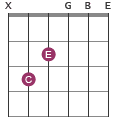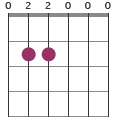Guitar chords – a collection of chords and tips
Guitar Chord is the site for you who want to learn your first guitar chords or wish to discover new ones.You will furthermore find the theory of the chords and put in context with chord progressions and songs so you in an instant can begin to practice what you learn. All the theoretical substance has been minimized and you are given straightforward facts that helps you to get into the guitar playing right away.
Common chord types:
What is a guitar chord?
Guitar chords are groups of notes and these deliver harmony when played together. They can be used for everything from one-chord grooves to long progressions with key changes. Let’s look at the C major chord, which includes the notes C, E and G.

C Major chord
In this specific C chord (a chord can be played in many ways), there are five notes played together: C, E, G (open string), C and E (open string). We sometimes play the same note twice but in different octaves to get a richer sound in a chord.
A common way to separate guitar chords is in major and minor. There is a difference in sound between these: the major tends to sound cheerful or neutral as the minor has more of a sad character. Because of this, you hear more major chords in fast rock songs and lots of minor chords in ballads.
To accomplish new tone colors, additional notes can be added. As in this guitar chord:

C7 chord
The name of this chord is C7 and if you hear some blues in it you’re completely on the spot – these kinds of chords are regularly used in the style of blues.
The C7 chord consist of the notes C, E, Bb, C and E. As you may have noticed we no longer have a G note. Due to the construction of the guitar we sometimes have to skip some less important note in a chord. The fifth note, is the note that is commonly skipped in these cases. (Even on the piano, when things like this aren't forced, notes are sometimes left out because it otherwise would be too much harmonic notes together with additional melody notes.)
For the C chord, a B note can be added to create another flavor and that chord is called Cmaj7 (‘maj’ stands for major).

Cmaj7 chord
By releasing the second string (B-string) we have got – as the picture above shows – the following notes: C, E, G, B and C. Cmaj7 could be considered as richer in sound than the ordinary C major. There are the same numbers of tones, but less duplicates tones in Cmaj7 (one) compared to C major (two).
This group of chords are used in many music styles, but perhaps you associate the sound to melancholy ballads?
If we add the note D to the Cmaj7 chord we get yet another flavour:

Cmaj9 chord
The major 9 chord is for example used in jazz.
There are lots of them, all you really need to do is placing your fingers in a random position on the guitar's fretboard and you accomplish a guitar chord. But it is not until you do it with control and in organized form that music is created. The guitar chords are categorized in names (e.g. C, C7) and bigger groups. Some of the more common groups are defined as follows:
On this site you also find sus chords, slash chords and many other categories.
Sharps (#) and flats (b)
One thing to be familiar with is the sharps (#) and the flats (b). If you see a chord like C#, it is spelled "C sharp". And if you see a chord like Db, it is spelled "D flat". The next thing you should know is that C# and Db is exactly the same thing. They are written differently because the changing of keys.
Start playing chords
In case you have just begun playing guitar, learning some chords is a very good way to start. Try to memorize a few and then practice on switching between them.
1st step: Play one chord
Before you begin to move from one to chord to another, just stay on one chord and try some different strumming patterns. A strumming pattern usually consist of a mix of down- and upstrokes. The combinations of down- and upstrokes together with pauses and emphasizing some strokes creates a rhythm. If you don't play anything that sound rhythmically satisfactory, it won’t sound good regardless how many chords you move around with. So, first of all, just choose an easy chord and try to create some easy strumming sequences.
The diagram below show E minor and this a great chord to start with. It includes all six string, which enables you to strum very freely. Choose your own strumming patterns, or use one of the two suggestions:
1) down - down - up - down - up
2) down - down - up - up - down

2nd step: Play two chords
There is no need to hurry. After you feel secure strumming one chord it is time to expand with a second chord. To make it sound good when playing chords on guitar, you must be able to move between chords smoothly. Therefore, as a beginner you should start with chords that are easy to switch between. The following chord, an A minor, is quite similar to the E minor showed above.
Try to move between these two chords, but don't stress. Strum slowly and wait several beats before switching to the next chord and do the same until you switch back again.

3rd step: Learn other common chords
You may only know these two chords, but you have already adopted the two most fundamentally parts of guitar chord playing: rhythmic strumming and switching between chords. The goal is to do it with higher dexterity and with more chords.
When expanding your chord knowledge, a recommendation is to start by looking at open chords and learn the most common. In the end, your motivation will decide how large your stockpile of chords will be and how much your range of techniques to execute them with widen.
For the intermediate guitar player
Learning a new chord is always a good way to improve as a guitar player. Look around on this site and you will find several categories. Besides that, on Guitar-chord.org you also find articles and ebooks.
Some popular articles on the site:
Practice on chords – tips and tools | Movable chord shapes | Blues chords | Cool guitar techniques





















 6万+
6万+











 被折叠的 条评论
为什么被折叠?
被折叠的 条评论
为什么被折叠?








